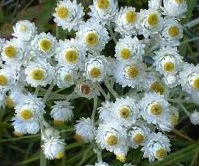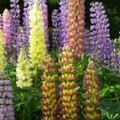- Mother’s Day Recipes You Can Make with Flowers - May 9, 2019
- Celebrating Flowers and Culture at the Shinnyo-en Lantern Floating Ceremony - March 29, 2018
- Give Easter Lilies This Spring - March 22, 2018
In a poll of what people hate doing the most, going to the dentist often falls somewhere between shopping for swimsuits and filing taxes. While the dentist’s chair is not our favorite place to be, it is somewhere we should find ourselves at least twice a year. For all those (sometimes dreaded) visits and repeated reminders to floss, March 6th is National Dentist Day. If you know a dentist who sometimes feels like their job is thankless, consider a bouquet of pearly everlasting. This gorgeous flower is the perfect way to say how much you appreciate their efforts taking care of your pearly whites.
Native to the United States and Canada, pearly everlasting (known by the Latin name (Anaphalis margaritacea)is a perennial plant with small white blooms gathered together in a cluster. Technically, the actual flowers are the small, yellow centers, surrounded by white, fuzzy bracts that form a symmetrical circle around the center about the size of a nickel. Arranged together in groups of 10 to 20, these delicate flowers make a big statement arranged in a vase with other wildflowers such as blue delphiniums or yellow solidago.
In the Victorian language of flowers, pearly everlasting is said to send the message “I think of thee” and “always remembered,” which is great for a dentist who always seems to remember your name, even when you’re only coming in every six months.
This plant can be grown and given as either a cut flower or a perennial for the landscape. In flower gardens, it is an important food for butterfly larvae and can tolerate dry, sandy soil as well as partial shade. They require very little care once established- unlike your teeth, which should be brushed and flossed daily.
As a cut flower, pearly everlasting looks great mixed in with flowering branches or colorful form flowers like gerber daisies or lilies. They will last longer than average stems in a vase.
Pearly everlasting gets its unique name from the pearl-like color of the blooms as well as its wonderful ability to preserve itself when dried. Hung upside down, this flower keeps both its shape and color one dry and can be used in other arrangements in the future. The plant is very hardy to cold temperature and all parts are completely edible (and low in sugar- so they won’t cause tooth decay:)





